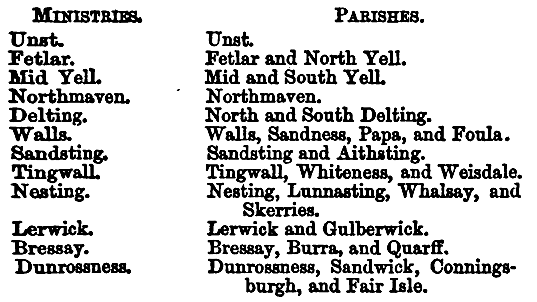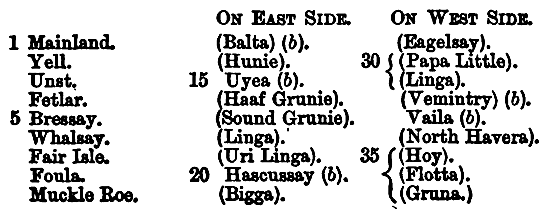|
INTRODUCTION AND GENERAL
ACCOUNT.
Situation—Natural
History—Scenery—List of Parishes and Islands.
THE group of islands
constituting the county of Shetland or Zetland extends from lat. 59° 51'
to 60° 50' north, and between long. 0° 40' and 1° 50' west. On their
western coast they are washed by the Atlantic Ocean, and on the eastern
by the North Sea ; and they may thus be said to form, in their own
latitude, a boundary line between these two seas. Shetland lies
north-east from the extreme north of the mainland of Scotland,
north-east from Orkney, southeast from Faroe, and west from Bergen, in
Norway. The islands which constitute this, the most northerly county in
Scotland, are upwards of a hundred in number, and vary by numerous and
irregular gradations in size, from the mainland, seventy-two miles in
length and thirty at its greatest breadth, to various detached rocks,
scarcely large enough to afford a temporary resting-place for a few
sea-fowl. In shape they are very irregular; and being much intersected
by voes, or arms of the sea, as well as separated from each other by
different distances, appear to form the skeleton of a former country or
continent. The extent of sea-coast is thus immense, in proportion to the
superficial area of the country, which is estimated by Captain Thomas at
356,000 acres. So much is the land indented by these arms of the sea,
that at no point is it possible to be farther from the sea than three
miles. -The general appearance of the country is hilly, but none of the
hills rise to a great height. The coast-line facing the ocean may be
said to consist of a series of bold headlands and cliffs, the shores
more gradually sloping towards the sea only where the placid water of
voes and sounds renders them useful to man. The geological formation of
the islands is primary, overlaid in many places along the east side by
rocks of the transition period, which in their turn, in a few instances,
are covered by, or give place to, some* of the lower divisions of the
secondary. The soil of the interior of most of the larger islands is
made up almost entirely of deep beds of peat-moss. Owing to the
irregularity of the ground and the moist nature of the climate, the
inland parts of the surface are studded with numerous fresh-water lakes
of all sizes, which send burns or small streams down through the
ravines, by courses more or less circuitous, to the sea. By the action
of small water-courses these large tracts of peat-moss are frequently
marked by deep clefts, which give the heath-clad interior a sombre and
bleak aspect. As might be expected from its situation and geological
formation, the flora of Shetland is of what may be termed the
Scandinavian type. The climate also gives the flora a western character,
allying it with that of the Hebrides and the west of Scotland. The
shores of these islands abound with algae and marine fauna; and sea-fowl
of every wing nestle in their cliffs and feed in their waters. Their
seas teem with fish of every kind, which constitutes the great staple of
the inhabitants. The land-birds and quadrupeds are much the same as
those of the north of Scotland.
The climate, although
rainy, is mild, equable, and very healthy, as I hope to be able to show.
If the inland landscapes
are comparatively tame and monotonous, the rock scenery of the coast is
always interesting, and often truly grand and magnificent. Here you have
the lofty mural precipice rearing its mighty head a thousand feet above
the angry waves, till it is capped with clouds; there the solitary islet
rising precipitately out of the troubled waters, and pointing with
sharp-peaked columns to the skies: now you behold a huge rock pierced by
a triumphal arch, through which any Roman conqueror’s galley could have
passed; and anon the flat green isle, feeding on its fertile breast
flocks of timid lambs: here, as far as the eye can reach, is to be seen
the mighty iron-bound cliffs, whose stout buttresses bid defiance to the
fiercest waves of the stormy Atlantic; and there, like a blue cloud on
the verge of the horizon, is the lonely and lofty isle, which Agricola
saw from the Arcadian shore when he exclaimed, “Despecta est et Thule.”
Here the rocky coast sends out a long arm to do battle with ocean on the
day of his fiercest wrath; and there it is pierced by the cavern,
through which you can penetrate into the very bowels of mother Earth.
Ascend one of our everlasting hills, and you behold Oceanus again
invading Terra with his long sea-arm, which meanders far into the land,
between yon two ridges of hills. On the peaceful shore of this inland
sea stand the humble cottages of the hardy fishermen, surrounded by
fields of waving com, flourishing even beneath this hyperborean sky.
Perhaps you stand on the ruins of a watch-tower, whence the ancient
Picts or Norsemen gave warning of the approach of their enemies. Look to
the land, and you behold hills beyond hills, the brown sward of each
dappled over with the small species of sheep peculiar to the country, or
the better blown Shetland pony, browsing on the coarse grass, or the
more tender shoots of the young heather. Yonder runs the rippling rill,
where the young child loves to play. Look from the land, and there are
the green isles or dark rocks, gently sleeping on the bosom of the deep
blue sea. Its gentle waves are here and there speckled by the white sail
of the fishermen, as they go to and from the scene of their labours and
trials. Overhead is the summer’s sun, pouring down his bright and
cheering, but not scorching and enervating rays, to gladden all nature
around. Sounds there are none, save the distant bleating of the sheep,
the lowing of the cattle, the neighing of the ponies as they career
through their native hills, or the cackling of the seagull; or if,
perchance, you walk along the strand after the breeze has given place to
the calm, your ears aid you in fully appreciating the notable line of
Homer. Stand on the same hill on a stormy December day, and the scene is
greatly changed There are the wild waves tossing their white-crested
heads mountains high, and rushing on with the speed of a racehorse,
till, dashing with the force of their mighty artillery against the lofty
cliffs, they heave their white foam high into the air and far over the
hills. Such a scene is conceived by the poet when he says, “And Thule
bellows to her utmost isles/ Woe to the hapless mariner who has such a
coast for his lee-shore! Many an unfortunate bark has perished on these
shores; and even the lighthouses now established have not put an end to
wrecks.
The population of
Shetland, according to the census of 1871, was 31,605—18,525 females,
and 13,080 males. This population occupies twenty-eight islands, several
of the smaller islands containing only two, and one or two only one
family. Several of these isles, the most of which are very fertile, were
formerly inhabited, but have within the last few years been laid down to
grazing farms, such as Mousa, Balta, Samphray, Bigga, Vemintry, Papa
Little.
The islands are divided
into thirty parishes, which constitute twelve unions of parishes or
ministries. They are as follow:—

The following is a list
of the islands. Those in the first column are by far the most important,
and are arranged as nearly as possible according to size. The rest are
arranged according to situation, beginning at the north on each side of
the country. Those marked (b) are about the same size, and may be
classed next to those last mentioned in the first column. Those
uninhabited are enclosed within brackets thus ( ) ; and those forming
groups are classed together thus {.

|

